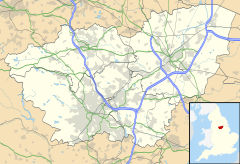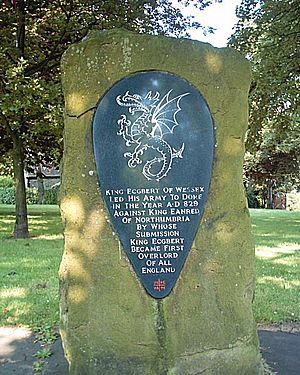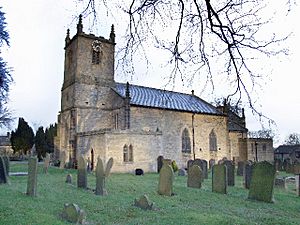Dore, South Yorkshire facts for kids
Quick facts for kids Dore |
|
|---|---|
| Population | 5,496 |
| OS grid reference | SK311812 |
| Metropolitan borough | |
| Metropolitan county | |
| Region | |
| Country | England |
| Sovereign state | United Kingdom |
| Post town | SHEFFIELD |
| Postcode district | S17 |
| Dialling code | 0114 |
| Police | South Yorkshire |
| Fire | South Yorkshire |
| Ambulance | Yorkshire |
| EU Parliament | Yorkshire and the Humber |
| UK Parliament |
|
Dore is a large village located in South Yorkshire, England. It sits on a hill above the River Sheaf, which is the river that gave the city of Sheffield its name. Until 1934, Dore was part of Derbyshire, but today it is a suburb of Sheffield.
Dore is served by Dore and Totley railway station, which is on the Hope Valley Line connecting Sheffield and Manchester. There's a very long railway tunnel between Dore and Totley that goes under part of the Pennines to Grindleford in Derbyshire. This tunnel is the longest main line railway tunnel in England, second only to the Severn Tunnel in Great Britain. Dore has a reputation for being one of Sheffield's wealthiest areas. The local Member of Parliament for Sheffield Hallam, which includes Dore, is Olivia Blake.
Contents
The History of Dore Village
What's in a Name? The Origin of Dore
The name Dore likely comes from one of two interesting origins. It might come from an Old English word that means 'door' or 'gateway'. This could refer to Dore being a pass or entrance between two ancient kingdoms.
Another idea is that the name comes from the Welsh word 'dwr' (pronounced 'dur'), which means 'water'. This makes sense because several streams meet in Dore. These streams, like the Limb Brook, River Sheaf, and Meers Brook, used to mark the border between the Anglo-Saxon kingdoms of Deira (which later became Northumbria) and Mercia.
Dore's Royal Past: King Egbert's Visit
The oldest written record of Dore is found in the Anglo-Saxon Chronicle. This historical book mentions that in 827 AD (or possibly 829 AD), King Egbert of Wessex led his army to Dore. Here, he met King Eanred of Northumbria. King Eanred agreed to accept King Egbert's rule. This event meant that King Egbert became the ruler over all of Anglo-Saxon Britain.
Because of this important meeting, many people believe that King Egbert became the first true king of all England right here in Dore. To remember this big moment, a special plaque was put up on the village green in 1968 by the Dore Village Society.
Old School and Christ Church
The Old School building in Dore was built in 1821. It stands on the same spot where an even older school once was. The right side of the building used to be where the teacher lived. When a new school for Dore was opened, the Old School was fixed up and now serves as a community centre for local events.
Christ Church Dore was built in 1828. Dore became its own separate church parish in 1844. For a long time, Dore remained a small village. In the 19th century, it only had about 500 people. It wasn't until 1934 that Dore officially became part of Sheffield.
In the 17th century, a paper mill was built on Avenue Farm. Later, in 1839, a man named Joshua Tyzack changed the building into a place where scythes (a type of farming tool) were made. In 1881, he built a large house next to the forge as a country getaway. You can still see his initials above the front door. In 1932, Dore's local council built a memorial to remember those who died in the First World War.
Schools in Dore
Dore has several schools for young people. These include Dore Primary School for younger students. For secondary school students, there is King Ecgbert School. There is also the Rowan Primary Special School. The historic Old School building is still used for community events, like meetings for groups such as Brownies.
Famous People from Dore
Many well-known people have lived in Dore, especially famous sports figures!
- Gary Megson, a former footballer and manager for teams like Sheffield Wednesday F.C..
- Dave Bassett, a former footballer and manager for clubs such as Southampton F.C. and Sheffield United.
- Chris Waddle, a former England international footballer who also played for Sheffield Wednesday.
- Bryan Robson, a former manager for Sheffield United and a famous player for Manchester United, owns a home in Dore.
- The late Emlyn Hughes, a former England footballer and captain, also lived in the village.
- Michael Vaughan, a famous cricketer from Yorkshire County Cricket Club and a former captain of the England cricket team, lives here.
- Joe Root, another notable cricketer from Yorkshire and a former England cricket captain, was born and grew up in Dore.
- Jessica Ennis-Hill, an Olympic gold medalist from Sheffield, who went to King Ecgbert School in Dore, bought a property in the village in 2012.
Just north of Dore is Abbeydale Park, which used to be a county cricket ground for both Derbyshire and Yorkshire teams.




